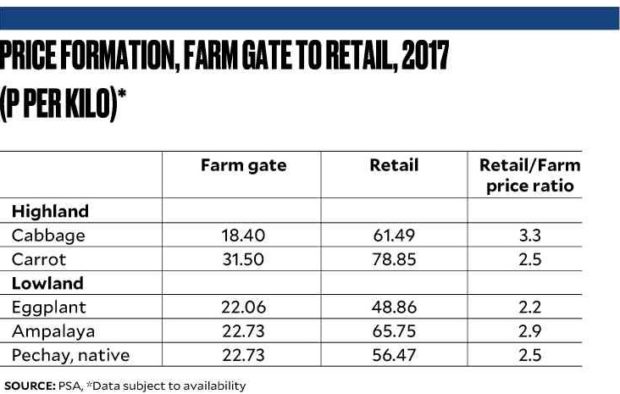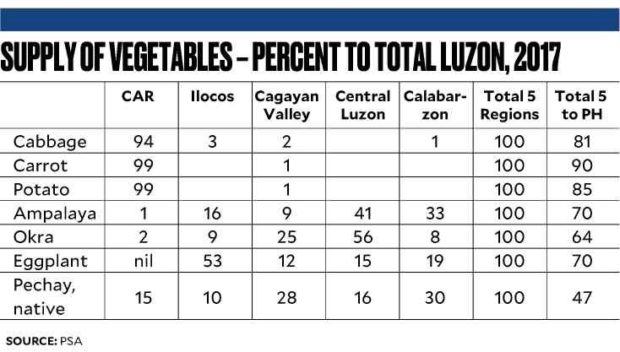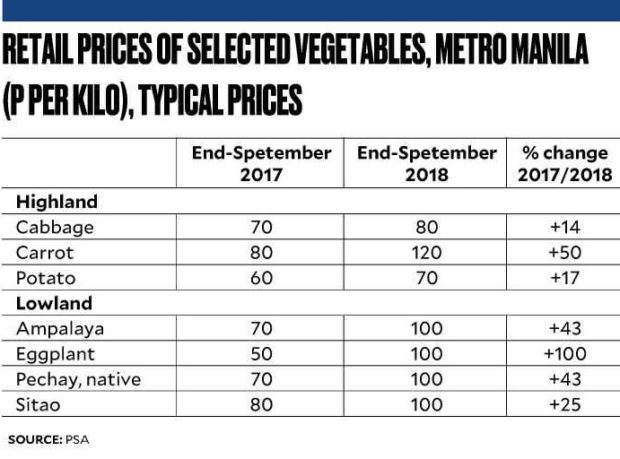Vegetables: The need for supply diversification
Whenever calamities hit the areas north of Manila, vegetable prices in the NCR go up. Events of 2018 bear this out. Vegetable prices grew fastest among the food groups. Inflation overtops its targets.
Vegetables comprise only 2.6 percent of the consumer price index but contributed a significant share to food inflation in 2018.
Retail price increases of selected vegetables in NCR ranged from 14 percent to 100 percent, or a simple average of 42 percent!
Where are the supply lines? Is there rationale to diversify sources?
Metro Manila is highly dependent on the northern regions for vegetable supply.
Cordillera Administrative Region (CAR) supplies highland vegetables for chopsuey (e.g., cabbage, carrots and potato). Other regions supply the pinakbet types (e.g., eggplant, ampalaya, pechay and sitao). Over 90 percent of the highland vegetables (cabbage, carrots and potato) are grown in CAR. Meanwhile, sourcing of lowland vegetables is more diversified but still dominated by regions north of Manila.
How are prices formed? Latest data showed that there appear to be inefficiencies in the supply chain. The ratios between retail and farm prices range from 2.2 to 3.3. These could be attributed in part to supply chain constraints, such as low yield, postharvest losses and logistics costs from farm to retail.
There are also weather disturbances (e.g. frost, rains, drought, floods) that affect supply and prices. For example, if there are typhoons, landslides occur, which lead to road closures. When roads are closed, traders stop buying vegetables from farmers as they cannot transport them anyway. Farmers, on the other hand, refrain from harvesting their vegetables as they cannot bring them to the trading post or traders are not there to buy.
Vegetable consumption in the Philippines is low at about 40 kilos per capita, according to vegetable expert Arsenio Barcelona. Data from the Food and Agriculture Organization indicate it is half of Thailand’s and a third of Vietnam’s. In November 2017, the retail prices of cabbage and eggplant in NCR were about twice that of Bangkok. Is high cost a factor in low consumption?
Finally, many constraints burden the vegetable supply chains. But there are potential solutions that can be explored by investors.
Given the supply chain, the route is geographic diversification. Vegetable production can be further developed in Calabarzon and Mindoro.
There are idle and unproductive lands for lease or for sale. Modern farming will generate high yields, more growing cycles and less climate risks.
If the supply base is diversified, price fluctuations can be minimized. Supply risks will be lower. Supply will not be completely compromised if one source is affected as there are alternative sources. Consumers will not suffer from price surges.
The shorter supply lines will also reduce logistics costs. Fresh produce will be of better quality. This strategy is good for both the investors and consumers.
This article reflects the personal opinion of the author and does not reflect the official stand of the Management Association of the Philippines or MAP. The author is the Co-Vice Chair of the MAP AgriBusiness Committee and the Executive Director of the Center for Food and AgriBusiness of the University of Asia & the Pacific. Feedback at <map@map.org.ph> and <rdyster@gmail.com>. For previous articles, please visit .



